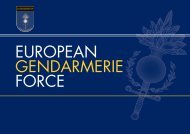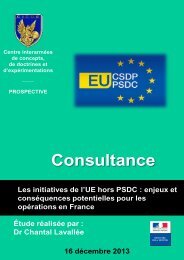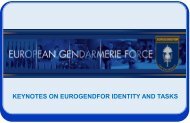Conference
science-research-bulletin-2013-conference
science-research-bulletin-2013-conference
You also want an ePaper? Increase the reach of your titles
YUMPU automatically turns print PDFs into web optimized ePapers that Google loves.
EUROPEAN POLICE SCIENCE AND RESEARCH BULLETIN<br />
SPECIAL CONFERENCE EDITION<br />
Development and runs from August 2010 to July<br />
2014. The consortium of COMPOSITE consists<br />
of 15 research institutes from ten countries (see<br />
Figure 1): Rotterdam School of Management<br />
of the Erasmus University Rotterdam (the<br />
Netherlands, consortium leader), University of<br />
Antwerp (Belgium), University of Masaryk in Brno<br />
(Czech Republic), University of Applied Sciences<br />
of the Brandenburg Police (Germany), Fraunhofer<br />
Institute for Applied Information Technology FIT<br />
(Germany), Capgemini Telecom Media Defence<br />
(France), National Center for Scientific Research<br />
(France), Foundation for Research on the Migration<br />
and Integration of Technologies FORMIT (Italy), St.<br />
Kliment Ohridski University Skopje/Bitola (Former<br />
Yugoslav Republic of Macedonia), University<br />
of Utrecht (the Netherlands), Police Academy<br />
in Apeldoorn (the Netherlands), Department<br />
of Psychology of the Babes-Bolyai University<br />
(Romania), ESADE Business School (Spain), Business<br />
School of Durham University (United Kingdom),<br />
and Sheffield University (United Kingdom).<br />
SOURCE: COMPOSITE.<br />
In addition to the research teams, the project also<br />
includes an End User and Strategic Advisory Board<br />
from the participating countries to ensure a close<br />
connection to the police. The End User Board is<br />
an important part of the governing structure of<br />
COMPOSITE and is composed of police officers<br />
on a senior operational level. The members of<br />
the End User Board act as a sounding board for<br />
quality and relevance of the deliverables and are<br />
especially important for discussions on cultural and<br />
national differences in police work. The Strategic<br />
Advisory Board is a group of senior policy-makers<br />
and police chiefs from the participating countries<br />
who function as a consultancy and review board<br />
to ensure the strategic link between the project<br />
and the police forces in the respective country.<br />
To move the comparative aspect of the research<br />
beyond written reports and empirical findings,<br />
COMPOSITE also initiated a photo project<br />
called COMPOSITE gallery which illustrates the<br />
similarities and differences in everyday working life<br />
of police officers in the 10 participating countries.<br />
Two professional photographers travelled all over<br />
Europe and caught remarkable scenes as well as<br />
insightful impressions of the inner workings of the<br />
visited police departments. The pictures can be<br />
seen online via www.composite.rsm.nl.<br />
The goal of the COMPOSITE research project is not<br />
restricted to the extension of scientific knowledge<br />
and theory building, but it will also help improve<br />
management of police forces and thus save public<br />
funds by providing benchmarks and learning<br />
opportunities, increase the performance of police<br />
forces across the EU and help to deepen existing<br />
networks and inter- as well as intra-organisational<br />
ties between forces.<br />
RESEARCH OBJECTIVES AND<br />
WORK PACKAGES<br />
COMPOSITE covers a wide range of research<br />
questions and objectives. It is divided into 11<br />
work packages (WP), four of which deal with<br />
project management, academic integration,<br />
dissemination as well as an exploitation strategy.<br />
Seven work packages cover the empirical aspects<br />
of COMPOSITE:<br />
• WP 1 looked at the relevant issues on the<br />
change agenda in European police forces,<br />
the opportunities and threats as well as the<br />
primary stakeholder of police forces (Van den<br />
Born & van Witteloostuijn, 2011; Van den<br />
Born, 2013).<br />
• WP 2 investigated the ability of police forces<br />
to react to social, political and economic<br />
challenges and identified those police<br />
practices that serve as strategies to adapt to<br />
those challenges (Graham, Betteridge, Casey<br />
& van Witteloostuijn, 2012).<br />
• The focus of WP 3 was on the description<br />
and comparative assessment of police<br />
communication while asking the questions<br />
of how information is distributed and<br />
communication is organised (Birdi, Allen,<br />
Turgoose, MacDonald & Vössing, 2012a;<br />
Birdi, Allen, Turgoose, MacDonald & Vössing,<br />
2012b).<br />
• WP 4 deals with technical trends and challenges<br />
to modern police work investigating the<br />
different ways of technological adaption<br />
(Denef et al., 2011; Denef, Kaptein, Bayerl &<br />
Ramirez, 2012).<br />
• WP 5 is designed to identify the influence of<br />
cultural factors on the ability of police forces<br />
to change and attempts to measure specific<br />
155





